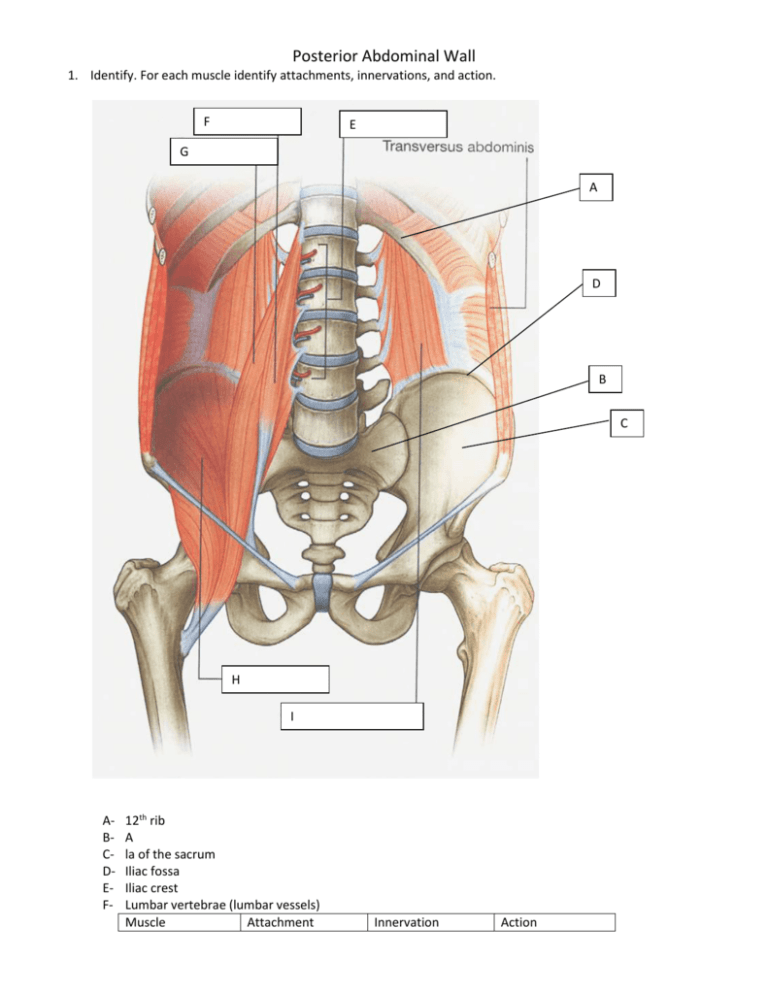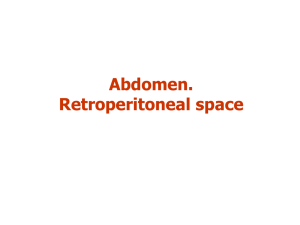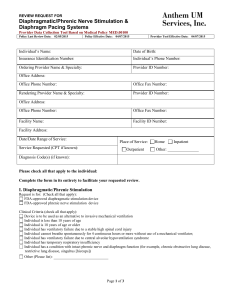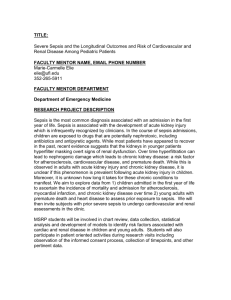Posterior Abdominal Wall
advertisement

Posterior Abdominal Wall 1. Identify. For each muscle identify attachments, innervations, and action. F E G A D B C H I ABCDEF- 12th rib A la of the sacrum Iliac fossa Iliac crest Lumbar vertebrae (lumbar vessels) Muscle Attachment Innervation Action Psoas Minor (F) Psoas Major (G) Iliacus (H) Quadratus Lumorum (I) T12-L1, binds to superior pubic ramus T12, lumbar vertebrae and intervetebral discs, lateral sides of lumbar vertebrae, lesser trochanter on femur. Iliac fossa, ala of sacrum, sacroiliac ligament Superior-12th rib; Medially-TVP of lumbar vertebrae, illiolumbar ligament (occurs between TVP of L5 and iliac spine) Inferior-Iliac Crest None Ventral rami of L1L3 Femoral nerve (L2L4) Ventral Rami of T12-L4 Only appears in some people, no real function Flexes the leg at the hip joint Flexion of thigh, lateral rotation of thigh. Unilateral-lateral flexion of trunk; Bilateral-Extension of trunk 2. What is the illiopsoas? What is the illiopsoas test? The illiopsoas is the “combination” of the illiacus muscle and psoas muscle, considered because the muscles are so close to each other. The illiopsoas test tests for irritation in these muscles, can be caused by an inflamed appendix. G E F 3. Identify and describe A H I B J C D A- Quadratus Lumborum muscle B- Psoas muscle CDEFGHIJ- Left Crus of diaphragm Lumbar vertebrae Erector spinae muscle Middle fascia (formed by erector spinae muscle) Posterior fascia (formed by erector spinae muscle) Thoracolumbar fascia-formed by combination of the erector spinae fascias (middle and posterior) and the anterior fascia provided by quadrates lumborum Anterior fascia (formed by Quadratus lumborum ) Internal oblique/Transversalis abdominis muscles 4. How does a psoas abcess form? It forms when an infection occfurs at the lumbar vertebrae. When this happens, the infection will travel along the psoas muscle, but will be contained by the psoas fascia. This will keep the infection contained until it gets down to a break in the fascia at the thigh, where it will penetrate the skin and form an abcess at the thigh. 5. Label and describe. Special fact about L, M, N D A C B K N F L M G H J ABCDEF- I Inferior Vena cava Phrenic nerve- It innervates the deep surface of the diaphragm Central Tendon of diaphragm- various openings are here including to the IVC Superior epigastric artery coming through the sternocostal hiatus Lumbocostal triangle- Gap in the skeletal muscle fibers, herniations occur here frequently Greater splanchnic nerve- runs along the right and left crus E G- Attachment of the left crus- This crus is smaller than the right crus, it attaches to L1 or L2. The ligament of Treitz goes through this crus H- Attachment of the right crus- Comes down to L1-L3 and wraps around the esophagus to form the muscular portion of the esophageal sphincter, it is usually lower than the left crus. I- Quadratus Lumborum muscle traveling through the lateral arcuate ligament J- Psoas muscle traveling through the medial arcuate ligament K- Muscular portion of the diaphragm L- Medial arcuate ligament-the psoas muscle travels through here. It is formed by the fascia of the psoas muscle. Goes from L3 to the transverse process of L1 M- Lateral arcuate ligament-the quadratus lumborum muscle travels through here, it is formed by the fascia of the quadratus lumborum N- Median arcuate ligament-Formed by the tendinous fibers connecting right and left crus, the aorta travels through here The arcuate ligaments represent an attachment point for the muscular part of the diaphragm. 6. What causes hiccups? Hiccups are caused by irritation of the phrenic nerve, this leads to the diaphragm spontaneously contracting. 7. How do the Inferior Vena Cava, Esophagus and Aorta go through the diaphragm? What is the special connection between diaphragmatic contraction and function of these 3 things? IVC comes through diaphragm at T8, Esophagus at T10 and Aorta at T12. When the diaphragm contracts, it impacts IVC function greatly. During contraction, the pressure inside the abdomen is increased while the pressure inside the thorax is decreased, therefore, this will pump blood up through the IVC and towards the heart. The esophagus and aorta do not move much when the diaphragm contracts because they are located more posteriorly. 8. What neurons provide sensory input from the diaphragm? What neurons provide motor inputs from the diaphragm? Sensory information related to the diaphragm is provided by the afferent phrenic nerves (C3-C5) and the subcostal and intercostals nerves. Motor innervations to the skeletal muscles of the diaphragm is provided by the phrenic nerve (C3-C5) 9. What is the referred pain that can occur if the nerves of the diaphragm are irritated? Describe The referred pain that occurs happens in the shoulder, this is because the phrenic nerve is provided for by C3C5, therefore it shares innervations with the shoulder nerves and can lead to shoulder pain. 10. What can occur with a lesion to the phrenic nerve? If the phrenic nerve is cut, it can cause paradoxical movement of the deinervated side. If one side is cut and one side is normal, the innervated side will move properly downwards while the deinervated side will move improperly upwards. 11. How does the heart affect the diaphragm shape? The pericardium depresses the diaphragm slightly, creating 2 hemispheres on either end. 12. Describe the 4 arteries and veins that supply the diaphragm. a. Pericardiacophrenic- Comes off internal thoracic Travels through the diaphragm along with the phrenic nerve, it supplies the middle region of the diaphragm b. Musculophrenic- Branches off the internal thoracic arteries, supplies the anterior diaphragm. c. Superior phrenic- Comes of the abdominal aorta before it goes through the diaphragm. It supplies the posterior diaphragm on the superior surface. d. Inferior phrenic- Comes off the abdominal aorta immediately after crossing the diaphragm. It supplies the posterior diaphragm on the inferior surface 13. Identify and describe 1-3. 1. Unpaired visceral arteries (eg. Superior/Inferior mesenteric, celiac trunk, etc.) 2. Paired visceral arteries (eg branches to kidney, suprarenal gland) 3. Paired parietal arteries (eg. Arteries that supply the muscles of the abdominal cavity) 14. Label and describe the arteries A B C D E I F G H A-Inferior phrenic artery B- Right renal artery- Goes to kidneys-located at L1 C- Lumbar arteries-supplies the lumbar vertebrae, spinal cord, posterior abdominal wall D- Bifurcation of the aorta-occurs approximately at L4 E- Median sacral artery-occurs only in some people, supplies median surface of the sacrum F- Internal iliac artery-branch off the common iliac artery G- External iliac-branch off the common iliac artery H- Femoral artery-Continuation of the External iliac artery after crossing the inguinal canal. I- Common iliac (left)-One of the 2 branches (the other is the right common iliac) of the abdominal aorta J- Left gonadal artery-branches off aorta at L2 15. What is an aortic aneurysm? Any kind of aneurysm is weakness in the wall of the aorta, when it occurs in the abdomen, you can see pulses of the aorta that are in conjunction with the beating heart. 16. Label the veins that come off the inferior vena cava. B A C D I E H G F A/B- Left and Right hepatic veins- they drain the liver, closeness is seen because the liver runs up directly on the inferior vena cava C- Left phrenic vein-drains the diaphragm D- Right renal vein-shorter vein because displacement is not an issue E- Bifurcation of the IVC at L5 F- median sacral vein-drains the sacrum, this vein is shifted to the right because the IVC is shifted to the left, this point represents the location of the median sacrum G/H- External/Internal iliac veins- same pattern as arteries I-Left renal vein- Extended because IVC is towards the right, so it needs to extend further. There are numerous branches that drain into this vein instead of draining into the IVC. 17. Describe the abdominal lymphatic system. There are lymph nodes all over the place, they can be characterized into 2 main categories, visceral nodes and parietal nodes. Visceral nodes drain the viscera of the abdomen and will follow associated arteries and veins. Parietal nodes drain the abdominal wall and large arteries. Lymph flows from the visceral nodes to the parietal nodes then to the cisternae chyle. The cisternae chyle is the convergence of the lymphatic trunks located between the psoas muscle and the IVC at L1 and L2 vertebrae. Lymph then flows from the cisternae chyle to the thoracic duct. The lymph then goes into the thorax and drains into the venous system there. 18. What makes up the lumbar plexus? The lumbar plexus is formed by ventral rami of L1-L5, it provides sensory innervations to the skin and motor innervation to the muscle of the abdominal wall. It does NOT provide anything to the viscera of the abdomen. It is located around the psoas muscle. 19. Identify the nerves (and their origins) of the lumbar plexus. Describe their path thru the leg. A B C D E F G A- Iliohypogastric (L1)- Travel on anterior surface of psoas muscle B- Ilioinguinal (L1)-Travels on anterior surface of psoas muscle C- Genitofemoral (L1/L2)-Travels medially along the posterior abdominal wall, and along the surface of psoas major. Around the inguinal ring, the nerve splits into a genitor branch (to supply the cremaster muscle in males and labia majora in females) and a femoral nerve to supply the thigh. D- Lateral femoral cutaneous (L2/L3)- supplies skin on lateral aspect of upper thigh E- Femoral (L2-4)-supplies the iliacus muscle, travels under the inguinal ligament to supply the quadriceps muscle and thigh. F- Obturator (L2-4)- Drops into pelvic cavity on the medial side of the psoas. Innervates the ADductors of the thigh. G- Lumbosacral trunk (L4-L5)- Drops very deep into sacrum joins the sacral plexus. Lumbar contributions to the sacral plexus. 20. Label the dermatome map. A B C D E F G ABCDEFG- T12 and L1-subcostal,illiohypogastric nerves Femoral branch of genitofemoral nerve Ilioinguinal nerve Obturator nerve Lateral Cutaneous nerve of thigh Intermediate Cutaneous nerve of thigh Medial Cutaneous nerve of thigh 21. What are the functions of the kidneys? The function of the kidney is to remove excess water, salts and nitrogenous waste from the blood to produce urine. This urine is carried by the ureters to the bladder to be excreted. 22. What are places where the ureter narrows? What is special about these places? The ureter narrows in three locations: a. At the pelvic region as the ureter is leaving the hilus b. When the ureter crosses over the common iliac vessels c. When the ureter is about to enter the urinary bladder The special fact about these spots is that these are the locations where kidney stones are most common. 23. What is a kidney stone? What is the referred pain associated with kidney stones? A kidney stone is composed of organic salts that precipitate out of urine and remain stuck to the ureter. These salts will irritate the nerve supply (T11-L2) of the kidney. As the kidney stone moves through the ureter, you can start with referred pain in the back region, but then it moves to the groin region as the kidney stone itself moves. 24. Where is the kidney located? The kidney is a retroperitoneal organ that is located on the posterior abdominal wall, located around T12 to L3. The hilum of the left kidney is at L1, while the hilum for the right kidney is lower, this is because the liver is so large that it depresses the kidney 25. Label the following diagram, describe each term. C B A E F H D G A- Cortex- Glomeruli are found here, the capillaries extend and this is where filtration begins B- Renal columns- Glomeruli that extend into the sinus C- Medualla/Renal pyramids- parts of the medulla will form in between the renal columns. At the top of the pyramid is an apex that is continuous with the renal sinus. D- Minor calyx-cup like structure that surrounds the apex of each pyramid. E- Major calyx- 2-3 minor calyx come together to form major calyx F- Renal sinus- This is the entire cavity that the hilus opens up into. The renal sinus consists of the major and minor calyx, renal artery and vein. The renal sinus contains the renal pelvis, fat, and autonomic nerves. G- Renal pelvis-First part of ureter, also where all major calyx come together. H- Renal Hilus- Point of entry for the ureter and renal blood vessels. 26. What are renal cysts? Renal cysts form when there is a blockage in the glomeruli. This prevents fluid from going towards the hilum and therefore, fluid will build up in the glomeruli. 27. Describe and label the renal coverings. B A F D C E ABCDE- Perirenal fat- Located on the outside of the capsule, it is continuous with the fat in the sinus. Parietal peritoneum Pararenal or paranephric fat- Fat that surrounds the kidney but is located within the renal fascia Renal fascia- Continuous with transversalis fasica laterally and psoas fascia medially. Surgical pathway to enter the kidney. This diminishes infection to other parts of the abdomen because it is not opened up. F- Fibrous capsule- Capsule that surrounds kidney. 28. What are suprarenal glands? What are the 2 major parts and their functions? Where are they located? What is the arterial supply, venous drainage and innervation? Suprarenal glands are glands located on the superior pole of the kidney, each one is covered by a thin fibrous capsule and is continuous with renal fascia. Functions: Cortex- produces and secretes corticosteroids and androgens. Medulla - Chromaffin cells produces and secretes catecholamines (epinephrine and norepinephrine)The chromaffin cells are innervated by preganglionic sympathetic fibers of the greater splanchnic nerve. Location: Retroperitoneal, along the posterior abdominal wall near vertebral level T11. Between the superomedial aspect of the kidney and the diaphragm. Surrounded by its own fibrous capsule (separate from the fibrous renal capsule) as well as by the perirenal fat, renal fascia and pararenal fat. Arterial Supply: Superior suprarenal artery - branch off of inferior phrenic artery Middle suprarenal artery - branch off of abdominal aorta Inferior suprarenal artery - branch off of renal artery Venous drainage: Left suprarenal vein drains into the left renal vein Right suprarenal vein drains into the inferior vena cava Innervation: greater splanchnics








